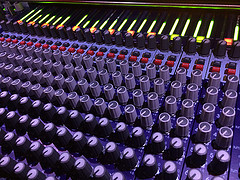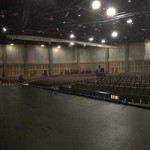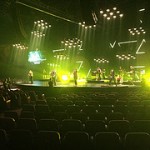
State of the Mix 2014: Less and Less
I’ve been noticing an increasing trend when I’m mixing lately that’s interesting to me. I seem to be doing less and less. I don’t know if I’m just getting lazy–I don’t think I am–or what the deal is, but when I start looking at my inputs, there’s just not as much going on as I think I used to do. Lately it doesn’t seem so out of the ordinary for me to just put the fader where it belongs and that’s that.
Part of this goes back to that whole idea of getting the source right to begin with. If the source is good, console stuff should just be icing on the cake, and that’s most of what I see happening. There’s a little bit of compression here and there. There’re bits EQ’ing to make things play nicer together here and there, but that’s really it. I’m still not afraid to really crank on something if need be, but that’s the exception to the norm right now.
I think something I saw popping up a lot in interviews and articles about a year ago was how important balance is when mixing. Balance is really the whole game, but the gist of the articles and interviews was how you get your faders balanced is a bigger deal than all the other stuff.
In all honesty, I had a hard time completely buying into this idea. I think part of that was because most of the guys saying it were guys who get handed things in great shape to begin with. When they sit down to mix, the sources under their fingers are great to fantastic, but that’s a luxury live sound doesn’t always offer. The show must go on after all so there’s a finite amount of time to have conversations with musicians and push mics around on stage. At some point we just make it happen.
But I must admit I’m also seeing a lot of truth in this lately. I think one of the things I spend the most time on while mixing is finessing faders to put or keep the whole thing in the pocket. It’s hard to explain exactly what I’m doing because it’s a combination of balancing the ability to hear specific instruments, letting other instruments blend into textures, and using the frequency space each instrument occupies to get an overall tonal feel.
On the one hand I want a listener to hear all the things they’re supposed to hear, but this also needs to be balanced across the frequency spectrum. If some things are too bright and painful and other things are too dull, but you still hear everything that’s still not a win. So I spend a lot of time trying different positions of things listening to what happens if I push the guitars more or back them off or push the lead vocal in one place and on and on and on. I still spend a good amount of time doing tweaking the other stuff while mixing, but it’s more time on this overall balancing bit vs. nickel and dime-ing everything.
I think one thing that shifted me from doing less is actually a mind shift I’ve gravitated towards more and more. Part of it is a conscious move, but I think part of it is just the result of mixing for a number of years and growing in confidence. I guess what I’m trying to say is I feel like the more I mix the more I move away from focusing on individual things and towards the overall everything. This is funny to me because my musical experience has been like a circle in this regard.
When I was young and listening to music for pure enjoyment, I just heard the whole thing. I heard the song. I wasn’t thinking about all these little things within the music. I’d get the melody and the overall feel of it, but that’s it. I wasn’t noticing things like delays or compression. I couldn’t have told you how many people were singing or how many guitars were playing. It was just music, and it was cool. Or maybe it wasn’t cool because something sounded weird. But that was all that mattered.
Then I started engineering and slowly the focus drifted to all these individual things. It’s details and details and details which is fine with me because I’m into details. But the details began to weigh more than the big picture, and when I’d listen to music I’m listening to all these details in the thing instead of the song.
This translated into into making each thing a thing and then somehow trying to put those things together when mixing. And all this time everything is happening so fast. Mixing is a blur because I’m stuck on all these little things and second-guessing things. It was like being constantly zoomed in and popping out for brief moments to see the whole picture before jumping back into the macro level.
But this was all a good thing.
Maybe for a while I lost sight of the picture, but I also grew in confidence and ability while doing this. By focusing in on all those details of the different things, I built a toolbox of approaches for all those different things.
So now when I’m listening to music, I can pull back and just listen again. I think I’ve always sort of retained that ability to an extent, but now I can be happy there once again. However, the difference now is that I can appreciate much more of the nuance that is happening, but instead of searching for these things I can just let the music draw me towards them.
And this translates to my mixing as well. As I’m pulling back to look at the big picture, I’m not worrying as much about all the details. Instead I’m focusing on the details I think matter which means there are less details. And less details to focus on means I’m doing less. And less on the console means I spend more time on the music. It’s less tech and more art which is what drew me into this work in the first place.
So go figure. Maybe less really can be more.


 Previous Post
Previous Post Next Post
Next Post



Dave, this is an outstanding, well-written article. We all need to remember to “move away from focusing on individual things and towards the overall everything”. Sure, you need to know what your plugins do and how they differ form one another, but its easy to forget that in the end, mixing really is balancing.
Thanks, John!